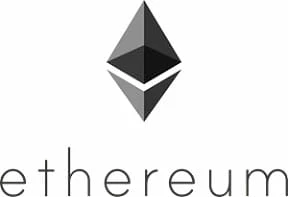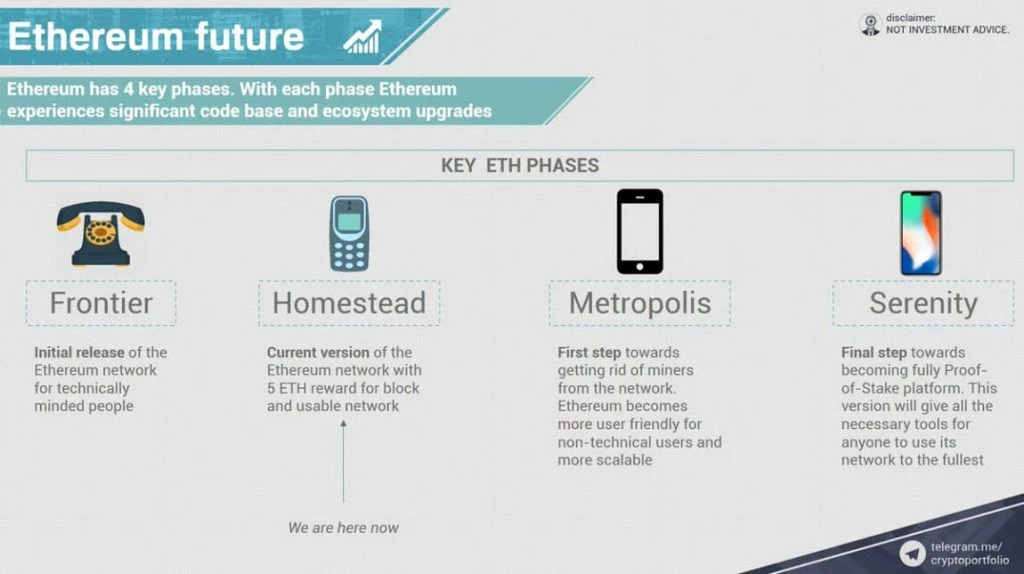Ethereum (ETH)
Cryptocurrency: Ethereum (ETH)

Official Website: https://www.ethereum.org/
What is Ethereum?
Ether (ETH) is the native cryptocurrency to the Ethereum network. Bitcoin and ETH share a lot of features, like that it can be sent to anyone in the world almost instantly and is solely digital. Ether (ETH), like some other coins, currently has no limited supply but are looking to change this in the near future. Ethereum varies from a lot of other coins as it is programmable. This means that developers of other Cryptocurrencies and more can use it to build new kinds of applications.
In addition, Ethereum implements a more advanced version of smart contracts compared to the one Bitcoin uses. Smart contracts can help exchange anything of value, like money, property or shares. This exchange, however, is done so without a middleman, giving the transaction transparency, trust and lower fees.
Ethereum Statistics
Circulating Supply 107,345,217 ETH
Maximum Supply No Data
All Time High $1,432.88
Blockchain Statistics
Consensus Algorithm Proof-of-Work (PoW), ETHASH
Average Block Time 15 Seconds
Transaction Cost $0.131 Avg.
Transaction Speed 15 tx/s
Mining CPU and GPU
Staking N/A
Block Explorer https://etherscan.io/
Social Media Statistics
Twitter Followers 448,000
Telegram Group Users 1,317
Reddit 444,000
Team
Vitalik Buterin, a programmer from Toronto, first grew interest in bitcoin in 2011. Only 2 years later, he published the primary Ethereum report, describing it as ‘an alternative platform designed for any type of decentralized application developers who would want to build’. In 2015, Ethereum’s development team, that consisted of founders: Vitalik Buterin, Mihai Alisie, Anthony Di Iorio, and Charles Hoskinson, announced the start of its development. In August later that year, they’d raised $18.4 million through launching a crowdfunding campaign, where participants purchased Ether (ETH) that function as shares within the project.
Dr Gavin Wood, who is the cofounder, created the Ethereum yellow paper, otherwise called “the technical bible”. This outlines the specification for the Ethereum virtual machine (EVM), which runs the smart contracts and engages with the state of the ledger.

Roadmap
Etheruem has been a platform for decentralised applications since its initial release in 2015, serving as a powerful computer with no risk of downtime or third-party interference. The network provides the Ethereum Virtual Machine (EVM), which executes scripts through a public node network. The Ethereum team have made many updates and adjustments to the system throughout the years to keep the system to the expected standard. Luckily, Ethereum have a roadmap which has been split into 4 different development stages to help convey their vision and plans. These stages are intended to symbolise different periods of progress: Frontier, Homestead, Metropolis and Serenity.
⦁ Frontier (July 2015) – Initially, Ethereum was designed primarily for developers, not for the end users, as the platform only featured command-line interfaces. The platform generated substantial potential that had blockchain developers persuaded. Experimentation followed, allowing developers to mine ETH and begin building dApps. Alas, it was still unstable, and improvements were required. Different elements of the network were fixed and adapted to allow the end users to start using the network. This was the first public version of Ethereum, and it was named Homestead.
⦁ Homestead (March 2016) – Ethereum Homestead, the first production release and hard fork, introduced several protocol and network improvements. One improvement was removing Canary Contracts, allowing the team at Ethereum the chance to stop certain activities within the network. This helped the platform to become more autonomous. New codes and a programming language called ‘Soldility’ were also introduced, which provided the ability to do further upgrades and speed up transactions.
⦁ Metropolis (October 2017) – Metropolis introduced a new consensus mechanism called Proof-of-Stake (PoS) at the last quarter of 2017. This diverges from the old Proof-of-Work (PoW) method, similar to Bitcoin (BTC), where transactions are confirmed by blockchain miners. This feature wads the main reason for the upgrade however, the network also saw security updates, as well as an increase in smart contract automation. Moreover, programmes that do not require downloading the entire blockchain locally, made it simpler for beginners.

Serenity (To be Announced) – The developers at Ethereum are regularly attempting to enhance their blockchain, giving different possibilities and updates. Ethereum hope to have the platform reach its full potential by the end of the Serenity stage, moving entirely to their Proof-of-Stake consensus algorithm.
Mining
Ethereum, like Bitcoin requires mining. Conceptually, they are both alike, but there are substantial technical differences. Ethereum blocks are added every 15 seconds, while bitcoin blocks are added at an average of every 10 minutes. Ethereum miners receive 2 ETH as a reward, plus all transaction and code-processing fees. Ethereum uses a hashing algorithm known as Ethash for the mining algorithm, which is different than Bitcoin’s hashcash. Ethash is a memory-hard algorithm, designed to resist the development of powerful Ethereum-mining ASICs in the hope of making mining more widely available to different users.
Smart Contracts and dApps
A smart contract on the Ethereum network, is not a smart nor a legal contract. However, they are computer programmes that run deterministically as aspect of the Ethereum network protocol (on the decentralized Ethereum world computer). Likewise, the fact that you need energy to power something, you also need Ether to operate the smart contracts and applications on the Ethereum network.
DApps stands for decentralized application. Like applications in different app stores, developers can build on top of Ethereum’s blockchain infrastructure/network. Ethereum is arguably the best platform for building dApps, as there is a huge amount of ERC20 tokens. This is due to its own language (Solidity) that enables developers to form smart contracts using the Ethereum Virtual Machine (EVM).
Examples that have been built of the Ethereum Virtual Machine. https://media.consensys.net/40-ethereum-apps-you-can-use-right-now-d643333769f7
Where to Store Ethereum (ETH)
You can follow this link https://ethereum.org/use/#3-what-is-a-wallet-and-which-one-should-i-use which provides a few different wallets through the Ethereum website for the storage of ETH. You can find mobile, browser and desktop wallets from 5 different providers all featured on the site. Most of the wallets are unofficial and developed by the community to improve and provide services on the open-source network. Leading hardware wallet providers Trezor and Ledger are integrated with Ethereum and a ETH wallets will come as standard on their devices.
Exodus and other dedicated wallet providers are also great for storing, sending and receiving any ETH you may already have or are looking to purchase. It is highly recommended that you ensure you are using a secure wallet, create back-ups and store any sensitive recovery information.
Where to Buy Ethereum (ETH)
Ethereum can be bought by heading over to the Binance website, where it can be bought with EUR or GBP. You can find more information about how to buy ETH on our ETH coin buying guide here.
Conclusion
Ethereum stands out from other cryptocurrencies thanks to its versatility. Unlike other networks Ethereum is that the world’s leading programmable blockchain, with many ERC20 tokens currently being supported on the Ether network. The team have a well-established plan for the long run offering stability and a way of direction for the coin. Ethereum has been one amongst the highest 3 crypto’s in terms of capitalisation and does not look to lose its place anytime soon. They are also looking to manoeuvre into a Proof-of-Stake/Proof-of-Work algorithm which is being closely monitored by the community for its success.
Ethereum Resources
Ethereum Website: https://www.ethereum.org/
Ethereum Block Explorer: https://etherscan.io/
Ethereum GitHub: https://github.com/ethereum
Ethereum Whitepaper: http://blockchainlab.com/pdf/Ethereum_white_paper-a_next_generation_smart_contract_and_decentralized_application_platform-vitalik-buterin.pdf
Social Media
Twitter: https://twitter.com/ethereum
Facebook: https://en-gb.facebook.com/ethereumproject/
Telegram: https://telegram.me/ether
Reddit: https://www.reddit.com/r/ethereum/
